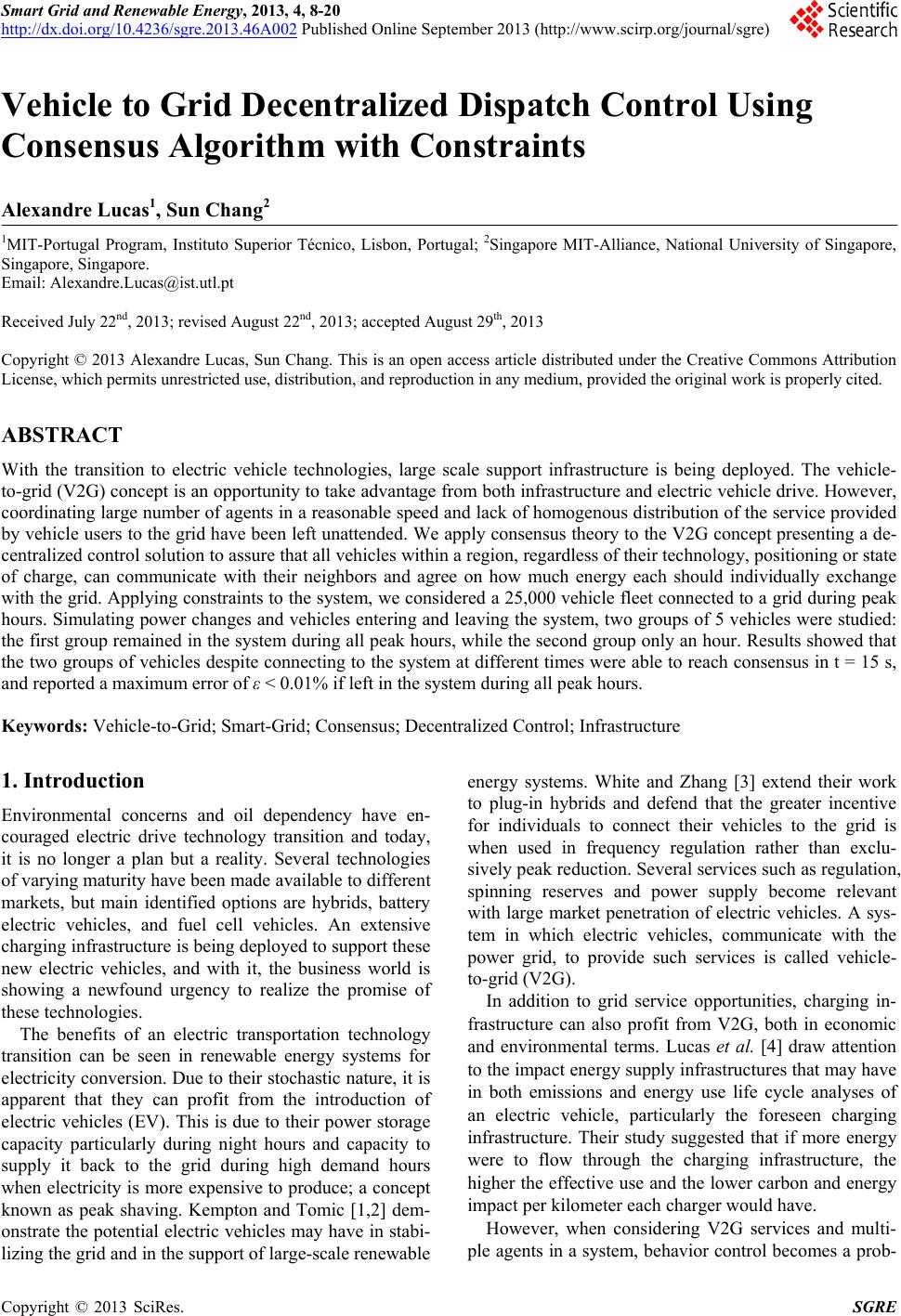 Smart Grid and Renewable Energy, 2013, 4, 8-20 http://dx.doi.org/10.4236/sgre.2013.46A002 Published Online September 2013 (http://www.scirp.org/journal/sgre) Vehicle to Grid Decentralized Dispatch Control Using Consensus Algorithm with Constraints Alexandre Lucas1, Sun Chang2 1MIT-Portugal Program, Instituto Superior Técnico, Lisbon, Portugal; 2Singapore MIT-Alliance, National University of Singapore, Singapore, Singapore. Email: Alexandre.Lucas@ist.utl.pt Received July 22nd, 2013; revised August 22nd, 2013; accepted August 29th, 2013 Copyright © 2013 Alexandre Lucas, Sun Chang. This is an open access article distributed under the Creative Commons Attribution License, which permits unrestricted use, distribution, and reproduction in any medium, provided the original work is properly cited. ABSTRACT With the transition to electric vehicle technologies, large scale support infrastructure is being deployed. The vehicle- to-grid (V2G) concept is an opportunity to take advantage from both infrastructure and electric vehicle drive. However, coordinating large number of agents in a reasonable speed and lack of homogenous distribution of the service provided by vehicle users to the grid have been left unattended. We apply consensus theory to the V2G concept presenting a de- centralized control solution to assure that all vehicles within a region, regardless of their technology, positioning or state of charge, can communicate with their neighbors and agree on how much energy each should individually exchange with the grid. Applying constraints to the system, we considered a 25,000 vehicle fleet connected to a grid during peak hours. Simulating power changes and vehicles entering and leaving the system, two groups of 5 vehicles were studied: the first group remained in the system during all peak hours, while the second group only an hour. Results showed that the two groups of vehicles despite connecting to the system at different times were able to reach consensus in t = 15 s, and reported a maximum error of ε < 0.01% if left in the system during all peak hours. Keywords: Vehicle-to-Grid; Smart-Grid; Consensus; Decentralized Control; Infrastructure 1. Introduction Environmental concerns and oil dependency have en- couraged electric drive technology transition and today, it is no longer a plan but a reality. Several technologies of varying maturity have been made available to different markets, but main identified options are hybrids, battery electric vehicles, and fuel cell vehicles. An extensive charging infrastructure is being deployed to support these new electric vehicles, and with it, the business world is showing a newfound urgency to realize the promise of these technologies. The benefits of an electric transportation technology transition can be seen in renewable energy systems for electricity conversion. Due to their stochastic nature, it is apparent that they can profit from the introduction of electric vehicles (EV). This is due to their power storage capacity particularly during night hours and capacity to supply it back to the grid during high demand hours when electricity is more expensive to produce; a concept known as peak shaving. Kempton and Tomic [1,2] dem- onstrate the potential electric vehicles may have in stabi- lizing the grid and in the support of large-scale renewable energy systems. White and Zhang [3] extend their work to plug-in hybrids and defend that the greater incentive for individuals to connect their vehicles to the grid is when used in frequency regulation rather than exclu- sively peak reduction. Several services such as regulation, spinning reserves and power supply become relevant with large market penetration of electric vehicles. A sys- tem in which electric vehicles, communicate with the power grid, to provide such services is called vehicle- to-grid (V2G). In addition to grid service opportunities, charging in- frastructure can also profit from V2G, both in economic and environmental terms. Lucas et al. [4] draw attention to the impact energy supply infrastructures that may have in both emissions and energy use life cycle analyses of an electric vehicle, particularly the foreseen charging infrastructure. Their study suggested that if more energy were to flow through the charging infrastructure, the higher the effective use and the lower carbon and energy impact per kilometer each charger would have. However, when considering V2G services and multi- ple agents in a system, behavior control becomes a prob- Copyright © 2013 SciRes. SGRE 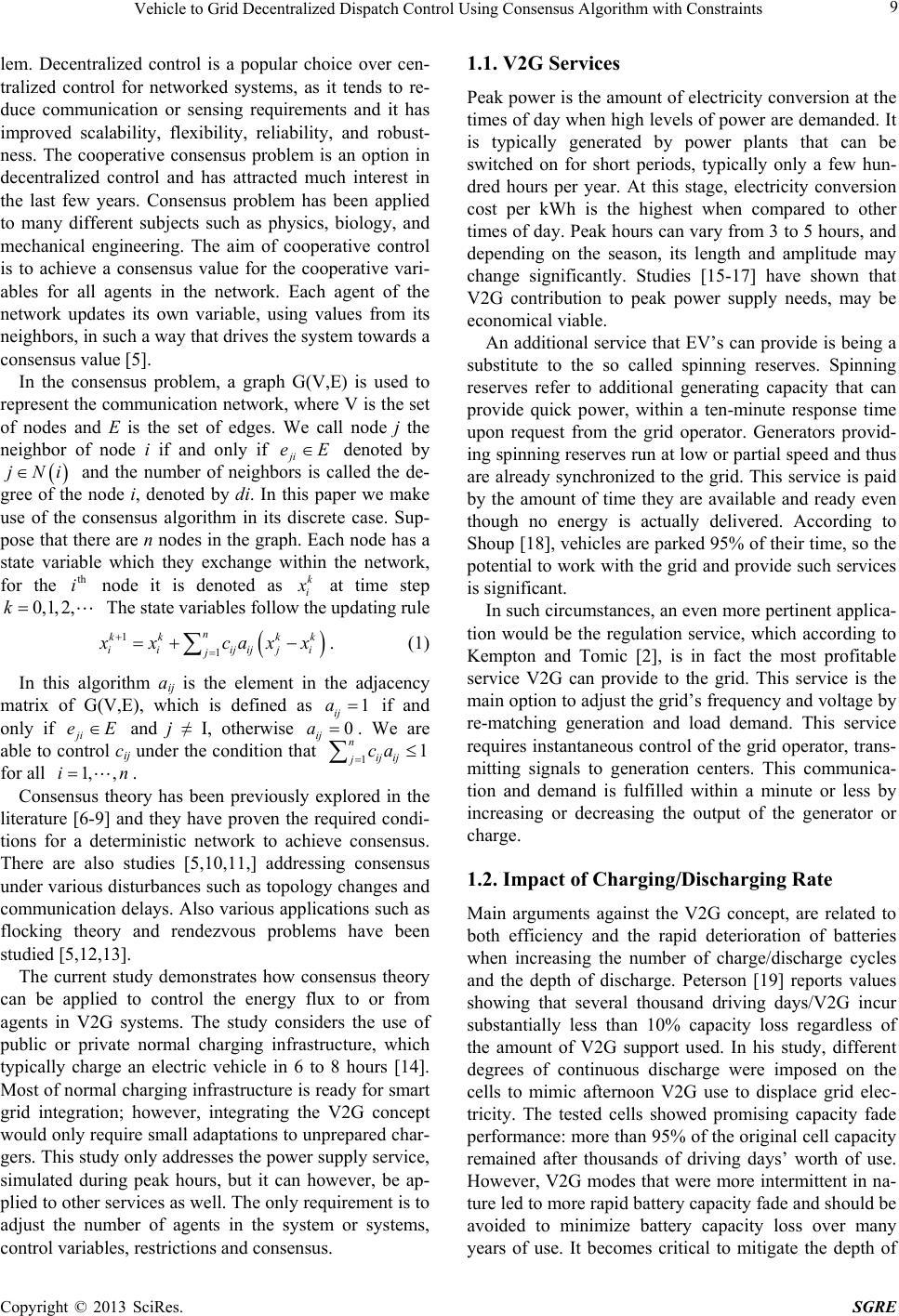 Vehicle to Grid Decentralized Dispatch Control Using Consensus Algorithm with Constraints 9 lem. Decentralized control is a popular choice over cen- tralized control for networked systems, as it tends to re- duce communication or sensing requirements and it has improved scalability, flexibility, reliability, and robust- ness. The cooperative consensus problem is an option in decentralized control and has attracted much interest in the last few years. Consensus problem has been applied to many different subjects such as physics, biology, and mechanical engineering. The aim of cooperative control is to achieve a consensus value for the cooperative vari- ables for all agents in the network. Each agent of the network updates its own variable, using values from its neighbors, in such a way that drives the system towards a consensus value [5]. In the consensus problem, a graph G(V,E) is used to represent the communication network, where V is the set of nodes and E is the set of edges. We call node j the neighbor of node i if and only if ji denoted by eE Ni i and the number of neighbors is called the de- gree of the node i, denoted by di. In this paper we make use of the consensus algorithm in its discrete case. Sup- pose that there are n nodes in the graph. Each node has a state variable which they exchange within the network, for the node it is denoted as th k i at time step The state variables follow the updating rule 0,1,2,k 1 1 n kk kk ii ijijji j xcax x . (1) In this algorithm aij is the element in the adjacency matrix of G(V,E), which is defined as if and only if ji and j ≠ I, otherwise . We are able to control cij under the condition that 1 ij a 0 ij 1 n j eEa 1 ij ij ca for all . 1, ,in Consensus theory has been previously explored in the literature [6-9] and they have proven the required condi- tions for a deterministic network to achieve consensus. There are also studies [5,10,11,] addressing consensus under various disturbances such as topology changes and communication delays. Also various applications such as flocking theory and rendezvous problems have been studied [5,12,13]. The current study demonstrates how consensus theory can be applied to control the energy flux to or from agents in V2G systems. The study considers the use of public or private normal charging infrastructure, which typically charge an electric vehicle in 6 to 8 hours [14]. Most of normal charging infrastructure is ready for smart grid integration; however, integrating the V2G concept would only require small adaptations to unprepared char- gers. This study only addresses the power supply service, simulated during peak hours, but it can however, be ap- plied to other services as well. The only requirement is to adjust the number of agents in the system or systems, control variables, restrictions and consensus. 1.1. V2G Services Peak power is the amount of electricity conversion at the times of day when high levels of power are demanded. It is typically generated by power plants that can be switched on for short periods, typically only a few hun- dred hours per year. At this stage, electricity conversion cost per kWh is the highest when compared to other times of day. Peak hours can vary from 3 to 5 hours, and depending on the season, its length and amplitude may change significantly. Studies [15-17] have shown that V2G contribution to peak power supply needs, may be economical viable. An additional service that EV’s can provide is being a substitute to the so called spinning reserves. Spinning reserves refer to additional generating capacity that can provide quick power, within a ten-minute response time upon request from the grid operator. Generators provid- ing spinning reserves run at low or partial speed and thus are already synchronized to the grid. This service is paid by the amount of time they are available and ready even though no energy is actually delivered. According to Shoup [18], vehicles are parked 95% of their time, so the potential to work with the grid and provide such services is significant. In such circumstances, an even more pertinent applica- tion would be the regulation service, which according to Kempton and Tomic [2], is in fact the most profitable service V2G can provide to the grid. This service is the main option to adjust the grid’s frequency and voltage by re-matching generation and load demand. This service requires instantaneous control of the grid operator, trans- mitting signals to generation centers. This communica- tion and demand is fulfilled within a minute or less by increasing or decreasing the output of the generator or charge. 1.2. Impact of Charging/Discharging Rate Main arguments against the V2G concept, are related to both efficiency and the rapid deterioration of batteries when increasing the number of charge/discharge cycles and the depth of discharge. Peterson [19] reports values showing that several thousand driving days/V2G incur substantially less than 10% capacity loss regardless of the amount of V2G support used. In his study, different degrees of continuous discharge were imposed on the cells to mimic afternoon V2G use to displace grid elec- tricity. The tested cells showed promising capacity fade performance: more than 95% of the original cell capacity remained after thousands of driving days’ worth of use. However, V2G modes that were more intermittent in na- ture led to more rapid battery capacity fade and should be avoided to minimize battery capacity loss over many years of use. It becomes critical to mitigate the depth of Copyright © 2013 SciRes. SGRE 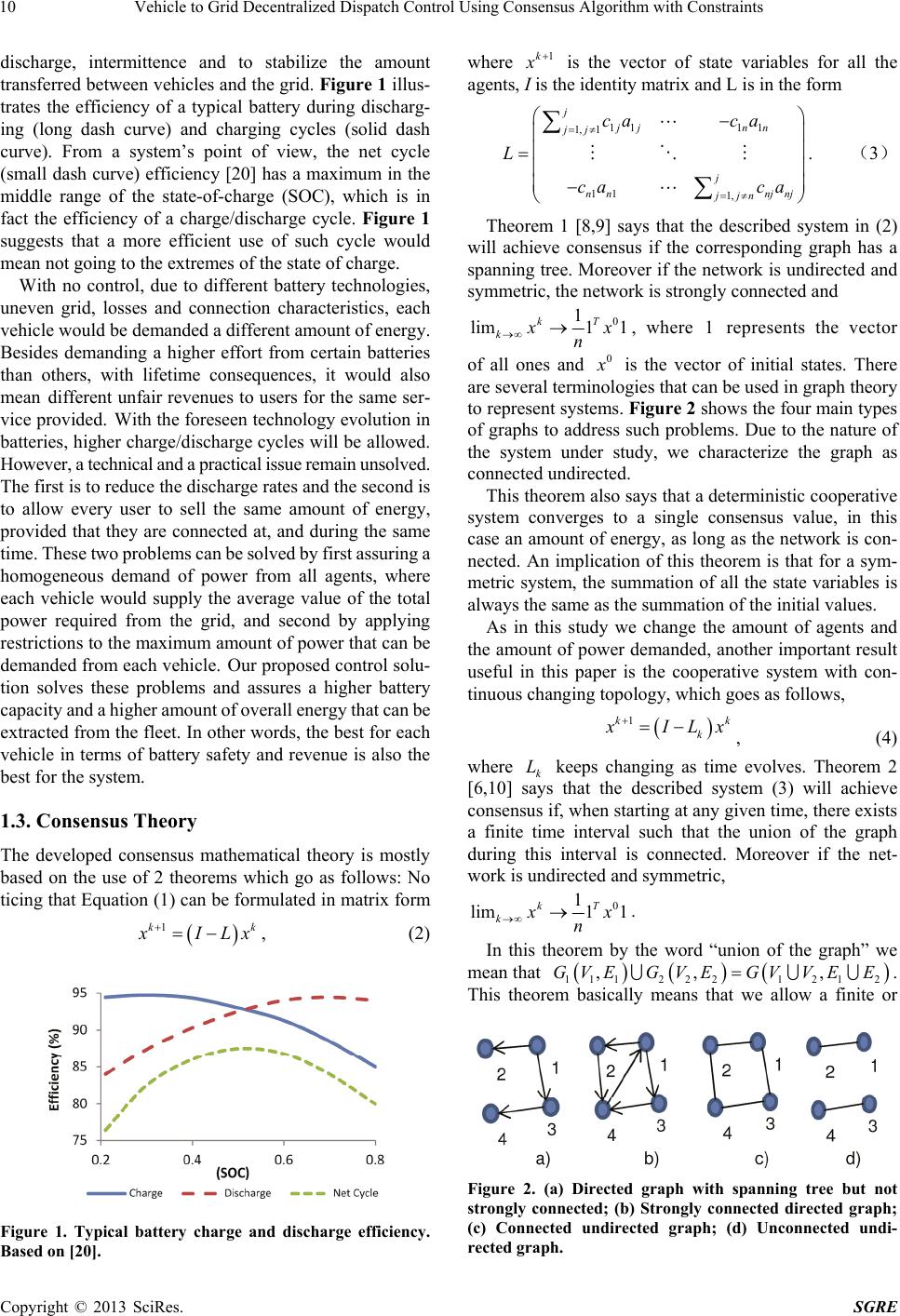 Vehicle to Grid Decentralized Dispatch Control Using Consensus Algorithm with Constraints 10 discharge, intermittence and to stabilize the amount transferred between vehicles and the grid. Figure 1 illus- trates the efficiency of a typical battery during discharg- ing (long dash curve) and charging cycles (solid dash curve). From a system’s point of view, the net cycle (small dash curve) efficiency [20] has a maximum in the middle range of the state-of-charge (SOC), which is in fact the efficiency of a charge/discharge cycle. Figure 1 suggests that a more efficient use of such cycle would mean not going to the extremes of the state of charge. With no control, due to different battery technologies, uneven grid, losses and connection characteristics, each vehicle would be demanded a different amount of energy. Besides demanding a higher effort from certain batteries than others, with lifetime consequences, it would also mean different unfair revenues to users for the same ser- vice provided. With the foreseen technology evolution in batteries, higher charge/discharge cycles will be allowed. However, a technical and a practical issue remain unsolved. The first is to reduce the discharge rates and the second is to allow every user to sell the same amount of energy, provided that they are connected at, and during the same time. These two problems can be solved by first assuring a homogeneous demand of power from all agents, where each vehicle would supply the average value of the total power required from the grid, and second by applying restrictions to the maximum amount of power that can be demanded from each vehicle. Our proposed control solu- tion solves these problems and assures a higher battery capacity and a higher amount of overall energy that can be extracted from the fleet. In other words, the best for each vehicle in terms of battery safety and revenue is also the best for the system. 1.3. Consensus Theory The developed consensus mathematical theory is mostly based on the use of 2 theorems which go as follows: No ticing that Equation (1) can be formulated in matrix form 1kk ILx , (2) Figure 1. Typical battery charge and discharge efficiency. Based on [20]. where 1k is the vector of state variables for all the agents, I is the identity matrix and L is in the form 11 11 1, 1 11 1, j jj nn jj j nnnj nj jjn ca ca L ca ca . (3) Theorem 1 [8,9] says that the described system in (2) will achieve consensus if the corresponding graph has a spanning tree. Moreover if the network is undirected and symmetric, the network is strongly connected and 01im 11l kT k x n , where 1 represents the vector of all ones and 0 is the vector of initial states. There are several terminologies that can be used in graph theory to represent systems. Figure 2 shows the four main types of graphs to address such problems. Due to the nature of the system under study, we characterize the graph as connected undirected. This theorem also says that a deterministic cooperative system converges to a single consensus value, in this case an amount of energy, as long as the network is con- nected. An implication of this theorem is that for a sym- metric system, the summation of all the state variables is always the same as the summation of the initial values. As in this study we change the amount of agents and the amount of power demanded, another important result useful in this paper is the cooperative system with con- tinuous changing topology, which goes as follows, 1kk k ILx , (4) where k keeps changing as time evolves. Theorem 2 [6,10] says that the described system (3) will achieve consensus if, when starting at any given time, there exists a finite time interval such that the union of the graph during this interval is connected. Moreover if the net- work is undirected and symmetric, L 01im 11l kT k x n . In this theorem by the word “union of the graph” we mean that 1112 2 21212 ,, ,GVEGVEGV VEE . This theorem basically means that we allow a finite or Figure 2. (a) Directed graph with spanning tree but not strongly connected; (b) Strongly connected directed graph; (c) Connected undirected graph; (d) Unconnected undi- rected graph. Copyright © 2013 SciRes. SGRE 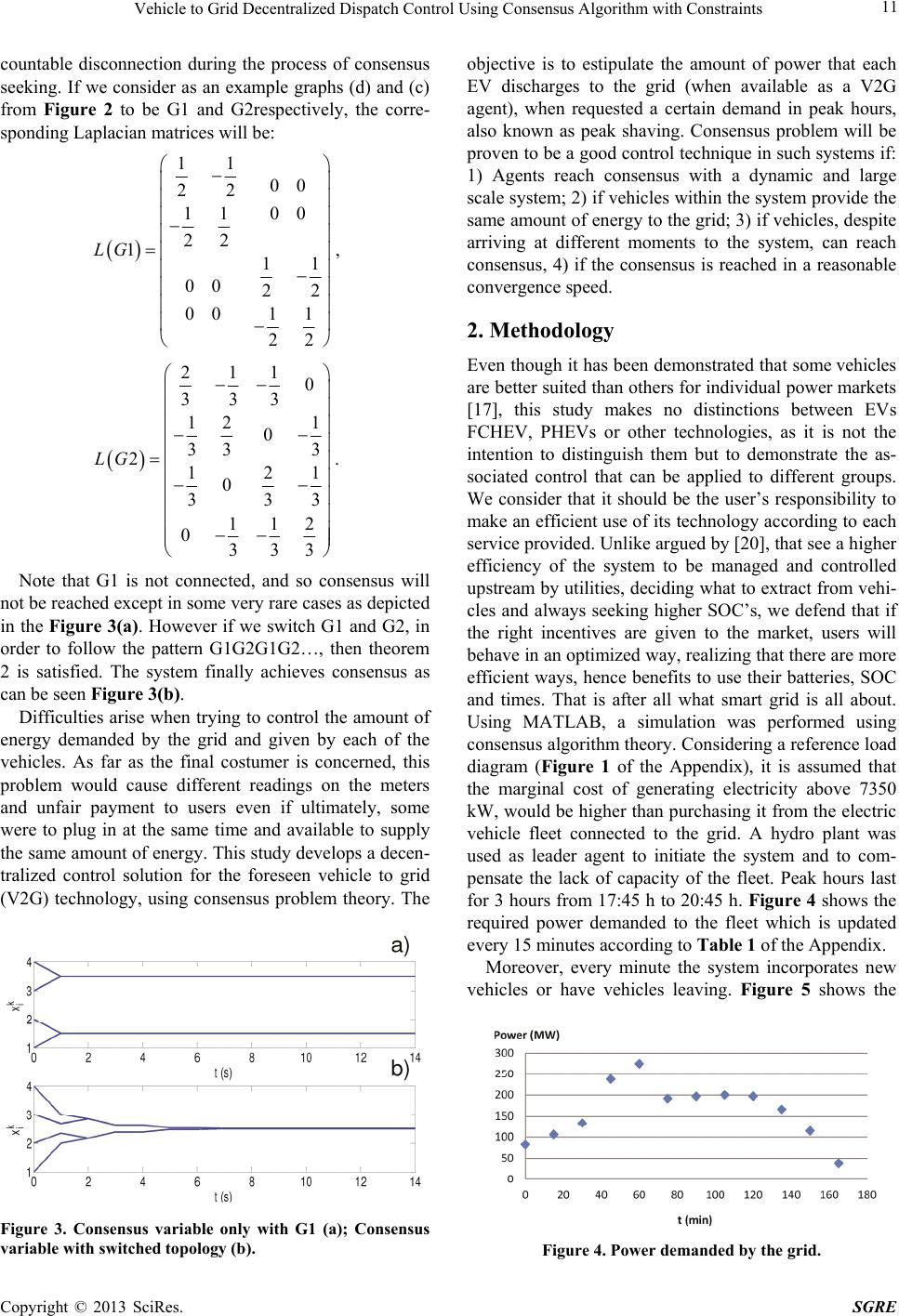 Vehicle to Grid Decentralized Dispatch Control Using Consensus Algorithm with Constraints 11 countable disconnection during the process of consensus seeking. If we consider as an example graphs (d) and (c) from Figure 2 to be G1 and G2respectively, the corre- sponding Laplacian matrices will be: 11 00 22 11 00 22 111 00 22 0011 22 LG , 211 0 333 12 1 0 33 3 212 0 33 112 0333 LG 1 3 . Note that G1 is not connected, and so consensus will not be reached except in some very rare cases as depicted in the Figure 3(a). However if we switch G1 and G2, in order to follow the pattern G1G2G1G2…, then theorem 2 is satisfied. The system finally achieves consensus as can be seen Figure 3(b). Difficulties arise when trying to control the amount of energy demanded by the grid and given by each of the vehicles. As far as the final costumer is concerned, this problem would cause different readings on the meters and unfair payment to users even if ultimately, some were to plug in at the same time and available to supply the same amount of energy. This study develops a decen- tralized control solution for the foreseen vehicle to grid (V2G) technology, using consensus problem theory. The Figure 3. Consensus variable only with G1 (a); Consensus variable with switched topology (b). objective is to estipulate the amount of power that each EV discharges to the grid (when available as a V2G agent), when requested a certain demand in peak hours, also known as peak shaving. Consensus problem will be proven to be a good control technique in such systems if: 1) Agents reach consensus with a dynamic and large scale system; 2) if vehicles within the system provide the same amount of energy to the grid; 3) if vehicles, despite arriving at different moments to the system, can reach consensus, 4) if the consensus is reached in a reasonable convergence speed. 2. Methodology Even though it has been demonstrated that some vehicles are better suited than others for individual power markets [17], this study makes no distinctions between EVs FCHEV, PHEVs or other technologies, as it is not the intention to distinguish them but to demonstrate the as- sociated control that can be applied to different groups. We consider that it should be the user’s responsibility to make an efficient use of its technology according to each service provided. Unlike argued by [20], that see a higher efficiency of the system to be managed and controlled upstream by utilities, deciding what to extract from vehi- cles and always seeking higher SOC’s, we defend that if the right incentives are given to the market, users will behave in an optimized way, realizing that there are more efficient ways, hence benefits to use their batteries, SOC and times. That is after all what smart grid is all about. Using MATLAB, a simulation was performed using consensus algorithm theory. Considering a reference load diagram (Figure 1 of the Appendix), it is assumed that the marginal cost of generating electricity above 7350 kW, would be higher than purchasing it from the electric vehicle fleet connected to the grid. A hydro plant was used as leader agent to initiate the system and to com- pensate the lack of capacity of the fleet. Peak hours last for 3 hours from 17:45 h to 20:45 h. Figure 4 shows the required power demanded to the fleet which is updated every 15 minutes according to Table 1 of the Appendix. Moreover, every minute the system incorporates new vehicles or have vehicles leaving. Figure 5 shows the Figure 4. Power de mande d by the grid. Copyright © 2013 SciRes. SGRE 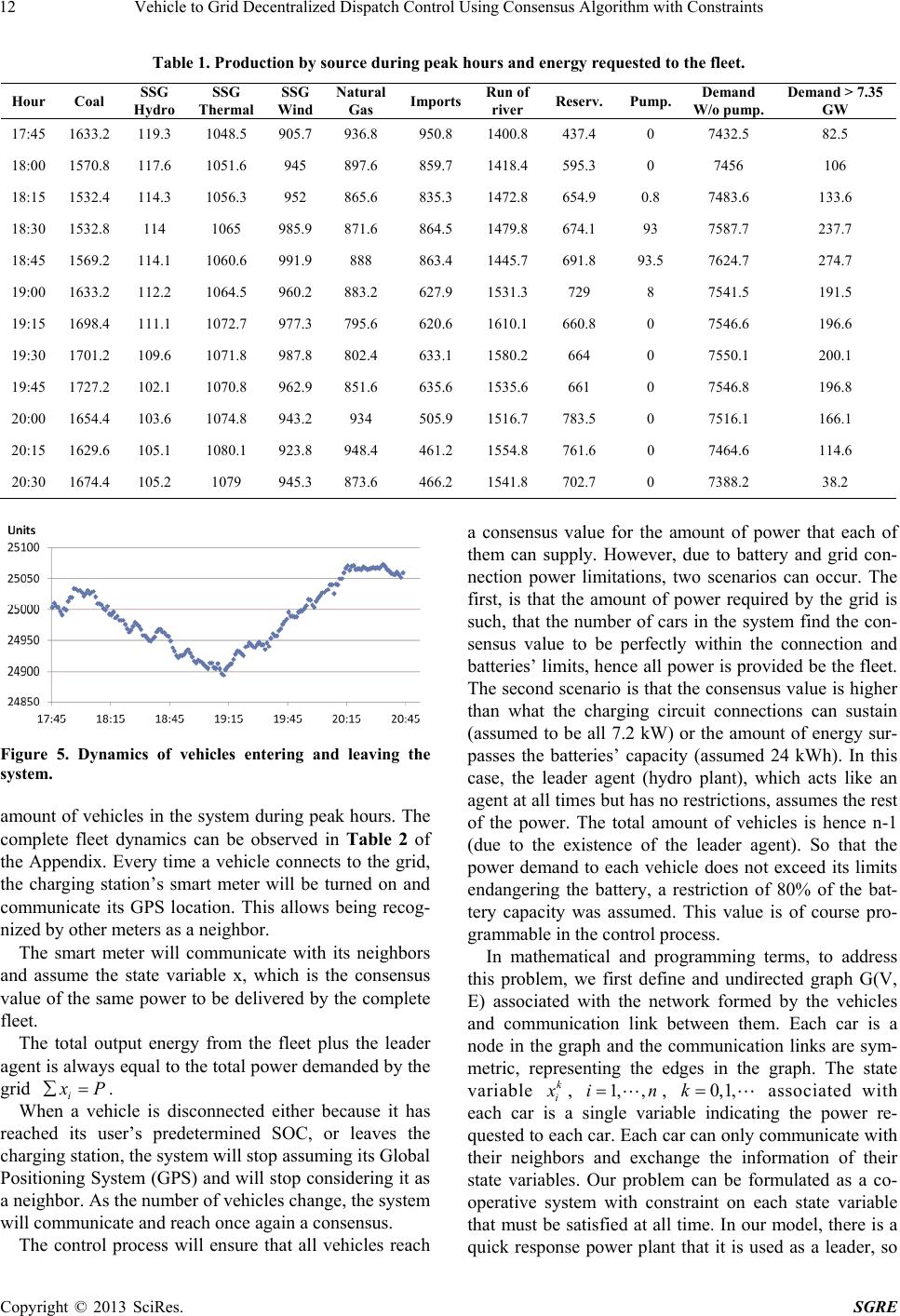 Vehicle to Grid Decentralized Dispatch Control Using Consensus Algorithm with Constraints Copyright © 2013 SciRes. SGRE 12 Table 1. Production by source during peak hours and energy requested to the fleet. Hour Coal SSG Hydro SSG Thermal SSG Wind Natural Gas Imports Run of river Reserv. Pump.Demand W/o pump. Demand > 7. 35 GW 17:45 1633.2 119.3 1048.5 905.7 936.8 950.8 1400.8437.4 0 7432.5 82.5 18:00 1570.8 117.6 1051.6 945 897.6 859.7 1418.4595.3 0 7456 106 18:15 1532.4 114.3 1056.3 952 865.6 835.3 1472.8654.9 0.8 7483.6 133.6 18:30 1532.8 114 1065 985.9 871.6 864.5 1479.8674.1 93 7587.7 237.7 18:45 1569.2 114.1 1060.6 991.9 888 863.4 1445.7691.8 93.5 7624.7 274.7 19:00 1633.2 112.2 1064.5 960.2 883.2 627.9 1531.3729 8 7541.5 191.5 19:15 1698.4 111.1 1072.7 977.3 795.6 620.6 1610.1660.8 0 7546.6 196.6 19:30 1701.2 109.6 1071.8 987.8 802.4 633.1 1580.2664 0 7550.1 200.1 19:45 1727.2 102.1 1070.8 962.9 851.6 635.6 1535.6661 0 7546.8 196.8 20:00 1654.4 103.6 1074.8 943.2 934 505.9 1516.7783.5 0 7516.1 166.1 20:15 1629.6 105.1 1080.1 923.8 948.4 461.2 1554.8761.6 0 7464.6 114.6 20:30 1674.4 105.2 1079 945.3 873.6 466.2 1541.8702.7 0 7388.2 38.2 Figure 5. Dynamics of vehicles entering and leaving the system. amount of vehicles in the system during peak hours. The complete fleet dynamics can be observed in Table 2 of the Appendix. Every time a vehicle connects to the grid, the charging station’s smart meter will be turned on and communicate its GPS location. This allows being recog- nized by other meters as a neighbor. The smart meter will communicate with its neighbors and assume the state variable x, which is the consensus value of the same power to be delivered by the complete fleet. The total output energy from the fleet plus the leader agent is always equal to the total power demanded by the grid i P. When a vehicle is disconnected either because it has reached its user’s predetermined SOC, or leaves the charging station, the system will stop assuming its Global Positioning System (GPS) and will stop considering it as a neighbor. As the number of vehicles change, the system will communicate and reach once again a consensus. The control process will ensure that all vehicles reach a consensus value for the amount of power that each of them can supply. However, due to battery and grid con- nection power limitations, two scenarios can occur. The first, is that the amount of power required by the grid is such, that the number of cars in the system find the con- sensus value to be perfectly within the connection and batteries’ limits, hence all power is provided be the fleet. The second scenario is that the consensus value is higher than what the charging circuit connections can sustain (assumed to be all 7.2 kW) or the amount of energy sur- passes the batteries’ capacity (assumed 24 kWh). In this case, the leader agent (hydro plant), which acts like an agent at all times but has no restrictions, assumes the rest of the power. The total amount of vehicles is hence n-1 (due to the existence of the leader agent). So that the power demand to each vehicle does not exceed its limits endangering the battery, a restriction of 80% of the bat- tery capacity was assumed. This value is of course pro- grammable in the control process. In mathematical and programming terms, to address this problem, we first define and undirected graph G(V, E) associated with the network formed by the vehicles and communication link between them. Each car is a node in the graph and the communication links are sym- metric, representing the edges in the graph. The state variable k i , 1, ,in , associated with each car is a single variable indicating the power re- quested to each car. Each car can only communicate with their neighbors and exchange the information of their state variables. Our problem can be formulated as a co- operative system with constraint on each state variable that must be satisfied at all time. In our model, there is a quick response power plant that it is used as a leader, so 0,1,k 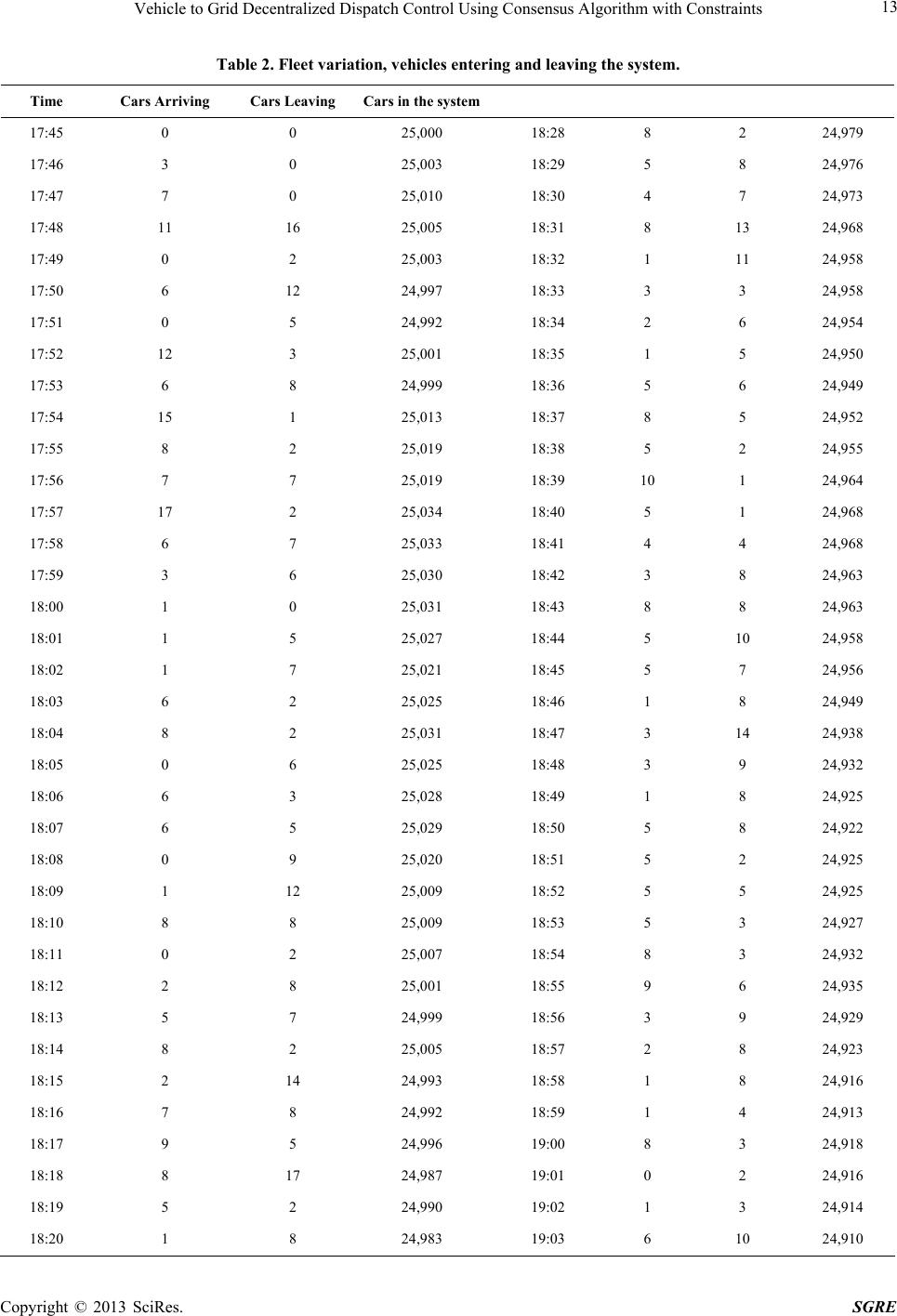 Vehicle to Grid Decentralized Dispatch Control Using Consensus Algorithm with Constraints 13 Table 2. Fleet variation, vehicles entering and leaving the system. Time Cars Arriving Cars Leaving Cars in the system 17:45 0 0 25,000 18:28 8 2 24,979 17:46 3 0 25,003 18:29 5 8 24,976 17:47 7 0 25,010 18:30 4 7 24,973 17:48 11 16 25,005 18:31 8 13 24,968 17:49 0 2 25,003 18:32 1 11 24,958 17:50 6 12 24,997 18:33 3 3 24,958 17:51 0 5 24,992 18:34 2 6 24,954 17:52 12 3 25,001 18:35 1 5 24,950 17:53 6 8 24,999 18:36 5 6 24,949 17:54 15 1 25,013 18:37 8 5 24,952 17:55 8 2 25,019 18:38 5 2 24,955 17:56 7 7 25,019 18:39 10 1 24,964 17:57 17 2 25,034 18:40 5 1 24,968 17:58 6 7 25,033 18:41 4 4 24,968 17:59 3 6 25,030 18:42 3 8 24,963 18:00 1 0 25,031 18:43 8 8 24,963 18:01 1 5 25,027 18:44 5 10 24,958 18:02 1 7 25,021 18:45 5 7 24,956 18:03 6 2 25,025 18:46 1 8 24,949 18:04 8 2 25,031 18:47 3 14 24,938 18:05 0 6 25,025 18:48 3 9 24,932 18:06 6 3 25,028 18:49 1 8 24,925 18:07 6 5 25,029 18:50 5 8 24,922 18:08 0 9 25,020 18:51 5 2 24,925 18:09 1 12 25,009 18:52 5 5 24,925 18:10 8 8 25,009 18:53 5 3 24,927 18:11 0 2 25,007 18:54 8 3 24,932 18:12 2 8 25,001 18:55 9 6 24,935 18:13 5 7 24,999 18:56 3 9 24,929 18:14 8 2 25,005 18:57 2 8 24,923 18:15 2 14 24,993 18:58 1 8 24,916 18:16 7 8 24,992 18:59 1 4 24,913 18:17 9 5 24,996 19:00 8 3 24,918 18:18 8 17 24,987 19:01 0 2 24,916 18:19 5 2 24,990 19:02 1 3 24,914 18:20 1 8 24,983 19:03 6 10 24,910 Copyright © 2013 SciRes. SGRE 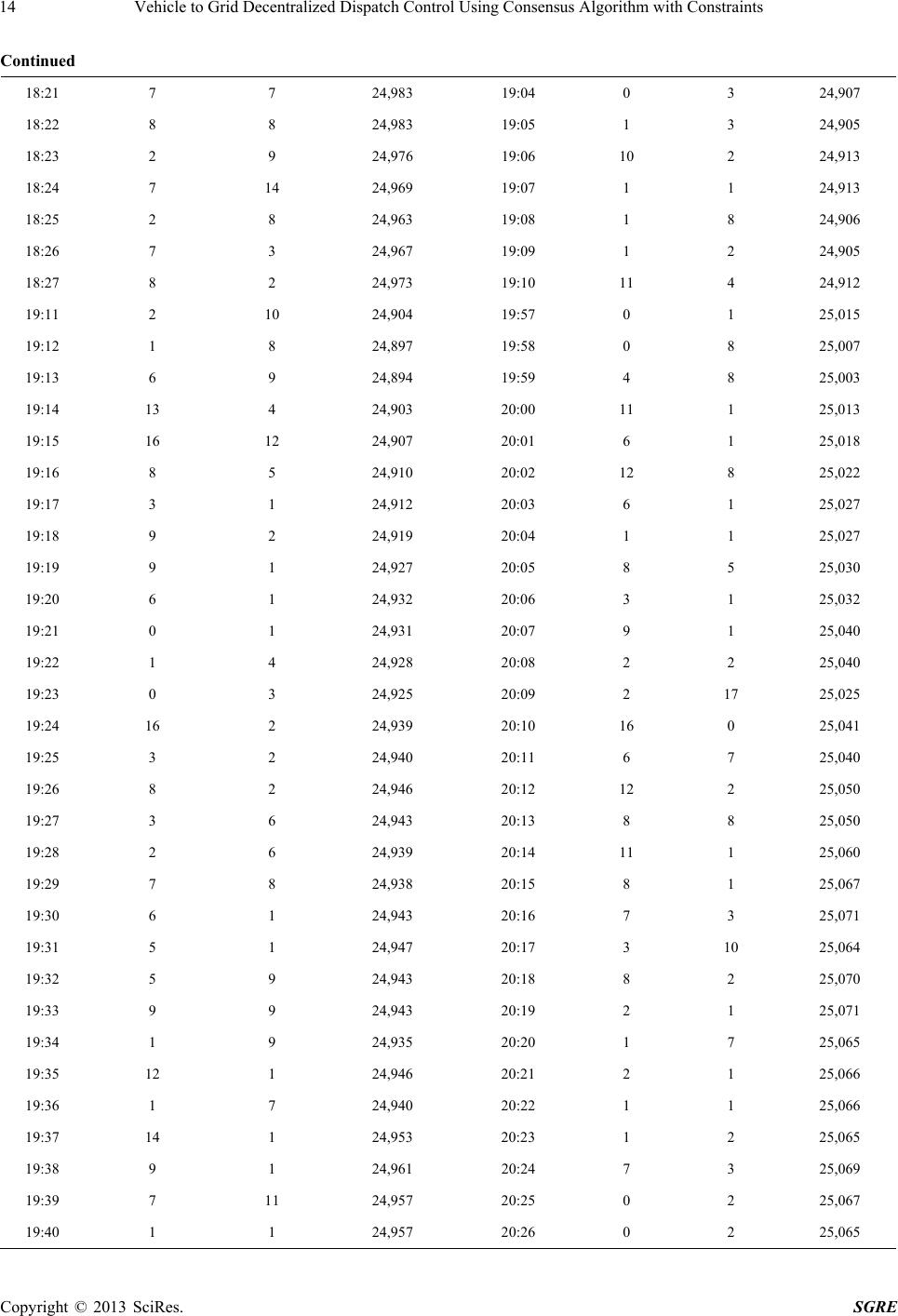 Vehicle to Grid Decentralized Dispatch Control Using Consensus Algorithm with Constraints 14 Continued 18:21 7 7 24,983 19:04 0 3 24,907 18:22 8 8 24,983 19:05 1 3 24,905 18:23 2 9 24,976 19:06 10 2 24,913 18:24 7 14 24,969 19:07 1 1 24,913 18:25 2 8 24,963 19:08 1 8 24,906 18:26 7 3 24,967 19:09 1 2 24,905 18:27 8 2 24,973 19:10 11 4 24,912 19:11 2 10 24,904 19:57 0 1 25,015 19:12 1 8 24,897 19:58 0 8 25,007 19:13 6 9 24,894 19:59 4 8 25,003 19:14 13 4 24,903 20:00 11 1 25,013 19:15 16 12 24,907 20:01 6 1 25,018 19:16 8 5 24,910 20:02 12 8 25,022 19:17 3 1 24,912 20:03 6 1 25,027 19:18 9 2 24,919 20:04 1 1 25,027 19:19 9 1 24,927 20:05 8 5 25,030 19:20 6 1 24,932 20:06 3 1 25,032 19:21 0 1 24,931 20:07 9 1 25,040 19:22 1 4 24,928 20:08 2 2 25,040 19:23 0 3 24,925 20:09 2 17 25,025 19:24 16 2 24,939 20:10 16 0 25,041 19:25 3 2 24,940 20:11 6 7 25,040 19:26 8 2 24,946 20:12 12 2 25,050 19:27 3 6 24,943 20:13 8 8 25,050 19:28 2 6 24,939 20:14 11 1 25,060 19:29 7 8 24,938 20:15 8 1 25,067 19:30 6 1 24,943 20:16 7 3 25,071 19:31 5 1 24,947 20:17 3 10 25,064 19:32 5 9 24,943 20:18 8 2 25,070 19:33 9 9 24,943 20:19 2 1 25,071 19:34 1 9 24,935 20:20 1 7 25,065 19:35 12 1 24,946 20:21 2 1 25,066 19:36 1 7 24,940 20:22 1 1 25,066 19:37 14 1 24,953 20:23 1 2 25,065 19:38 9 1 24,961 20:24 7 3 25,069 19:39 7 11 24,957 20:25 0 2 25,067 19:40 1 1 24,957 20:26 0 2 25,065 Copyright © 2013 SciRes. SGRE  Vehicle to Grid Decentralized Dispatch Control Using Consensus Algorithm with Constraints Copyright © 2013 SciRes. SGRE 15 Continued 19:41 13 4 24,966 20:27 1 0 25,066 19:42 7 4 24,969 20:28 1 0 25,067 19:43 8 1 24,976 20:29 1 0 25,068 19:44 7 2 24,981 20:30 2 3 25,067 19:45 7 3 24,985 20:31 4 3 25,068 19:46 12 1 24,996 20:32 2 3 25,067 19:47 2 8 24,990 20:33 5 2 25,070 19:48 1 1 24,990 20:34 5 1 25,074 19:49 8 9 24,989 20:35 2 6 25,070 19:50 1 1 24,989 20:36 3 8 25,065 19:51 8 1 24,996 20:37 5 7 25,063 19:52 3 1 24,998 20:38 2 6 25,059 19:53 1 1 24,998 20:39 4 5 25,058 19:54 7 4 25,001 20:40 3 4 25,057 19:55 7 2 25,006 20:41 8 4 25,061 19:56 12 2 25,016 20:42 3 7 25,057 20:43 5 10 25,052 20:44 9 1 25,060 that it adjusts its own state value at any time in order to satisfy the power demanded which is denoted as k for the time step. Without loss of generality, we use 1 P th k k to denote its state variable. Except the leader node, all the other nodes are representing cars and they all have a limitation on the maximum power they can provide, denoted by max and assumed to be the same for all the cars. With the notations introduced above, we can de- scribe our model with the following constrained coopera- tive system, To initialize the system at , we set 0 0k0 1 P and 00 i x for 2,, ,in 0k it is easy to verify that (6) is satisfied at . Moreover by theorem 1 if there is no change in power demanded and network topology, (6) is satisfied following the updating rule (5). Considering the dynamics introduced in the system, such as power demand and variation of vehicles we have the following behaviors: When there is a change in power demand at time k and 1kk k PP P , we set11 kk k x 1k k k ILx (5) P and continue up- dating the state variable using (5). Then constraint (6) is satisfied. Subjected to constraints 1Tk k P (6) Whenever there is a car entering the system at time k, supposing it is the car, we set 1 th 1n0 k n x and it will start to update its value according to equation (5). We have again constraint (6) being satisfied. max 2,,, 0,1,2, k i xx ink k (7) Whenever there is a car leaving the system at time k, supposing it is the car, this car sends a message that it is leaving the system and the value th m kk mm d to all its neighbors, where is the degree of node m at time k. Then, before going to the next time step we set k m d In our case, the size of and k will vary since there will be cars plugged in or off during a particular time period. This further complicates our model from the standard consensus problem. However by theorem 1 we can easily see that the constraint (6) can be satisfied if the network is symmetric i.e. k is symmetric at any time and the initial value of each state variable is set properly. L L k kk m ii k m x xiN d m and delete the node m and all Having assured that the system always reaches a con- sensus, it is still required to initialize the system and re- initialize the state variable. the edges connected to it from the graph. One can verify that constraint (6) is then satisfied. Using switching control, we guarantee that vehicles do 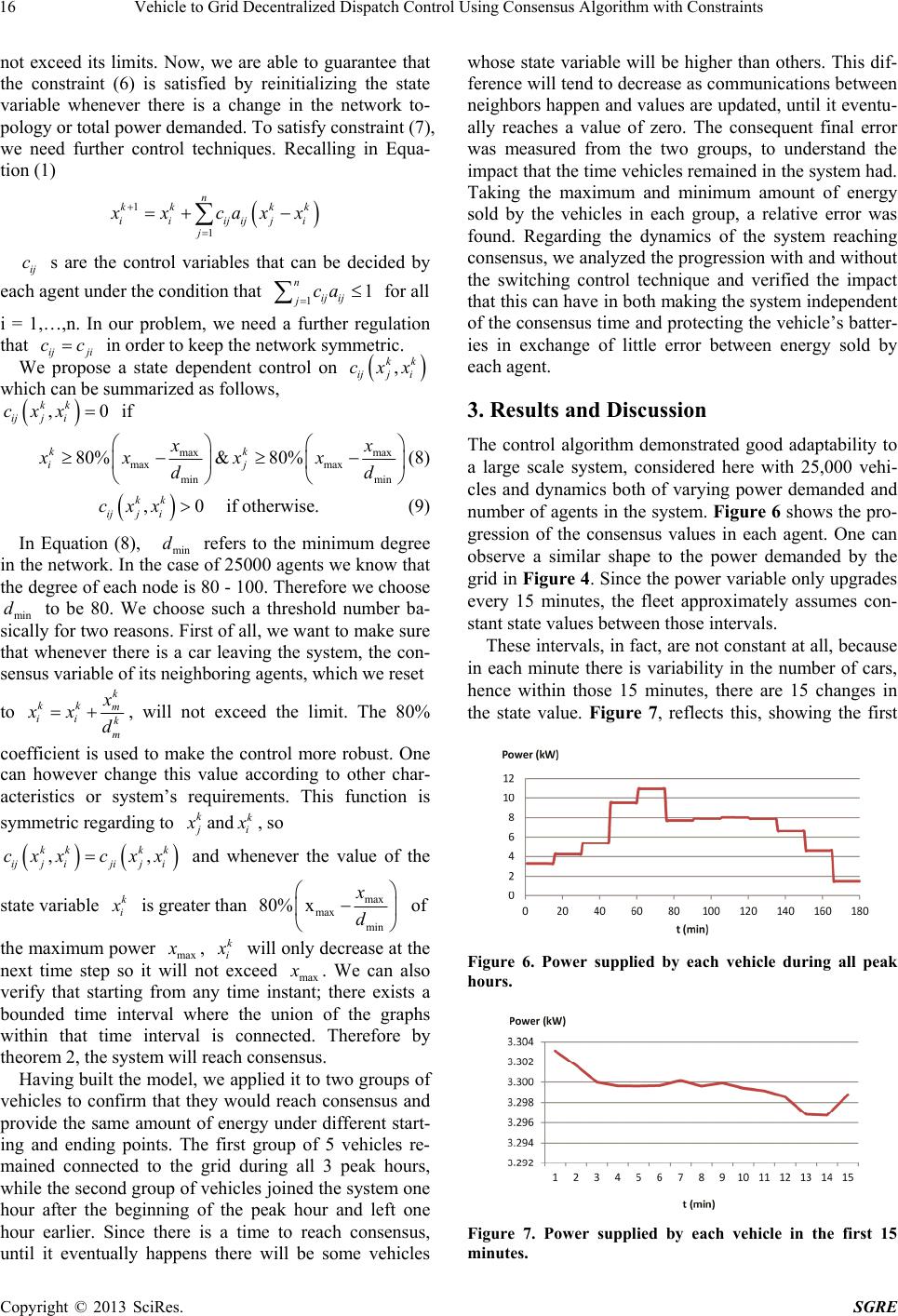 Vehicle to Grid Decentralized Dispatch Control Using Consensus Algorithm with Constraints 16 not exceed its limits. Now, we are able to guarantee that the constraint (6) is satisfied by reinitializing the state variable whenever there is a change in the network to- pology or total power demanded. To satisfy constraint (7), we need further control techniques. Recalling in Equa- tion (1) 1 1 n kk k ii ijijji j k xcaxx ij c s are the control variables that can be decided by each agent under the condition that for all 11 ij ij n jca i = 1,…,n. In our problem, we need a further regulation that in order to keep the network symmetric. ij ji We propose a state dependent control on cc , kk ijji cxx which can be summarized as follows, ,0 kk ijji cxx if max max max max min min 80%& 80% kk ij x xx xx d x d 0 (8) if otherwise. (9) , kk ijji cxx In Equation (8), min refers to the minimum degree in the network. In the case of 25000 agents we know that the degree of each node is 80 - 100. Therefore we choose min to be 80. We choose such a threshold number ba- sically for two reasons. First of all, we want to make sure that whenever there is a car leaving the system, the con- sensus variable of its neighboring agents, which we reset d d to k kk m ii k m xxd , will not exceed the limit. The 80% coefficient is used to make the control more robust. One can however change this value according to other char- acteristics or system’s requirements. This function is symmetric regarding to k and k i , so and whenever the value of the state variable , kk kk ijjijij i cxxcxx k i , is greater than max max min 80%xx d of the maximum power max , i k will only decrease at the next time step so it will not exceed max . We can also verify that starting from any time instant; there exists a bounded time interval where the union of the graphs within that time interval is connected. Therefore by theorem 2, the system will reach consensus. Having built the model, we applied it to two groups of vehicles to confirm that they would reach consensus and provide the same amount of energy under different start- ing and ending points. The first group of 5 vehicles re- mained connected to the grid during all 3 peak hours, while the second group of vehicles joined the system one hour after the beginning of the peak hour and left one hour earlier. Since there is a time to reach consensus, until it eventually happens there will be some vehicles whose state variable will be higher than others. This dif- ference will tend to decrease as communications between neighbors happen and values are updated, until it eventu- ally reaches a value of zero. The consequent final error was measured from the two groups, to understand the impact that the time vehicles remained in the system had. Taking the maximum and minimum amount of energy sold by the vehicles in each group, a relative error was found. Regarding the dynamics of the system reaching consensus, we analyzed the progression with and without the switching control technique and verified the impact that this can have in both making the system independent of the consensus time and protecting the vehicle’s batter- ies in exchange of little error between energy sold by each agent. 3. Results and Discussion The control algorithm demonstrated good adaptability to a large scale system, considered here with 25,000 vehi- cles and dynamics both of varying power demanded and number of agents in the system. Figure 6 shows the pro- gression of the consensus values in each agent. One can observe a similar shape to the power demanded by the grid in Figure 4. Since the power variable only upgrades every 15 minutes, the fleet approximately assumes con- stant state values between those intervals. These intervals, in fact, are not constant at all, because in each minute there is variability in the number of cars, hence within those 15 minutes, there are 15 changes in the state value. Figure 7, reflects this, showing the first Figure 6. Power supplied by each vehicle during all peak hours. Figure 7. Power supplied by each vehicle in the first 15 minutes. Copyright © 2013 SciRes. SGRE 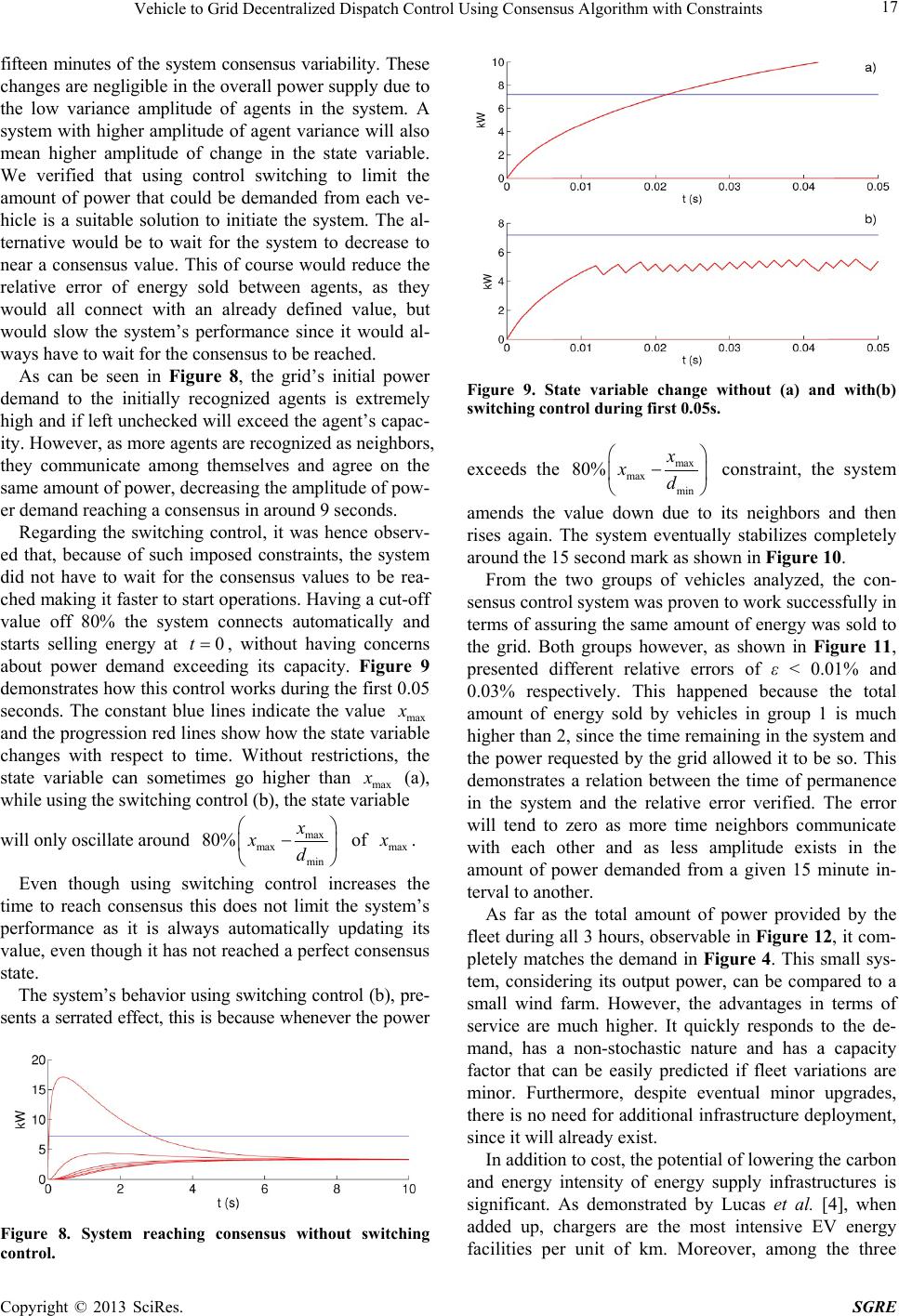 Vehicle to Grid Decentralized Dispatch Control Using Consensus Algorithm with Constraints 17 fifteen minutes of the system consensus variability. These changes are negligible in the overall power supply due to the low variance amplitude of agents in the system. A system with higher amplitude of agent variance will also mean higher amplitude of change in the state variable. We verified that using control switching to limit the amount of power that could be demanded from each ve- hicle is a suitable solution to initiate the system. The al- ternative would be to wait for the system to decrease to near a consensus value. This of course would reduce the relative error of energy sold between agents, as they would all connect with an already defined value, but would slow the system’s performance since it would al- ways have to wait for the consensus to be reached. As can be seen in Figure 8, the grid’s initial power demand to the initially recognized agents is extremely high and if left unchecked will exceed the agent’s capac- ity. However, as more agents are recognized as neighbors, they communicate among themselves and agree on the same amount of power, decreasing the amplitude of pow- er demand reaching a consensus in around 9 seconds. Regarding the switching control, it was hence observ- ed that, because of such imposed constraints, the system did not have to wait for the consensus values to be rea- ched making it faster to start operations. Having a cut-off value off 80% the system connects automatically and starts selling energy at , without having concerns about power demand exceeding its capacity. Figure 9 demonstrates how this control works during the first 0.05 seconds. The constant blue lines indicate the value max 0t and the progression red lines show how the state variable changes with respect to time. Without restrictions, the state variable can sometimes go higher than max (a), while using the switching control (b), the state variable will only oscillate around max max min 80% x xd max of . Even though using switching control increases the time to reach consensus this does not limit the system’s performance as it is always automatically updating its value, even though it has not reached a perfect consensus state. The system’s behavior using switching control (b), pre- sents a serrated effect, this is because whenever the power Figure 8. System reaching consensus without switching control. Figure 9. State variable change without (a) and with(b) switching control during first 0.05s. exceeds the max max min 80% x xd constraint, the system amends the value down due to its neighbors and then rises again. The system eventually stabilizes completely around the 15 second mark as shown in Figure 10. From the two groups of vehicles analyzed, the con- sensus control system was proven to work successfully in terms of assuring the same amount of energy was sold to the grid. Both groups however, as shown in Figure 11, presented different relative errors of ε < 0.01% and 0.03% respectively. This happened because the total amount of energy sold by vehicles in group 1 is much higher than 2, since the time remaining in the system and the power requested by the grid allowed it to be so. This demonstrates a relation between the time of permanence in the system and the relative error verified. The error will tend to zero as more time neighbors communicate with each other and as less amplitude exists in the amount of power demanded from a given 15 minute in- terval to another. As far as the total amount of power provided by the fleet during all 3 hours, observable in Figure 12, it com- pletely matches the demand in Figure 4. This small sys- tem, considering its output power, can be compared to a small wind farm. However, the advantages in terms of service are much higher. It quickly responds to the de- mand, has a non-stochastic nature and has a capacity factor that can be easily predicted if fleet variations are minor. Furthermore, despite eventual minor upgrades, there is no need for additional infrastructure deployment, since it will already exist. In addition to cost, the potential of lowering the carbon and energy intensity of energy supply infrastructures is significant. As demonstrated by Lucas et al. [4], when added up, chargers are the most intensive EV energy facilities per unit of km. Moreover, among the three Copyright © 2013 SciRes. SGRE 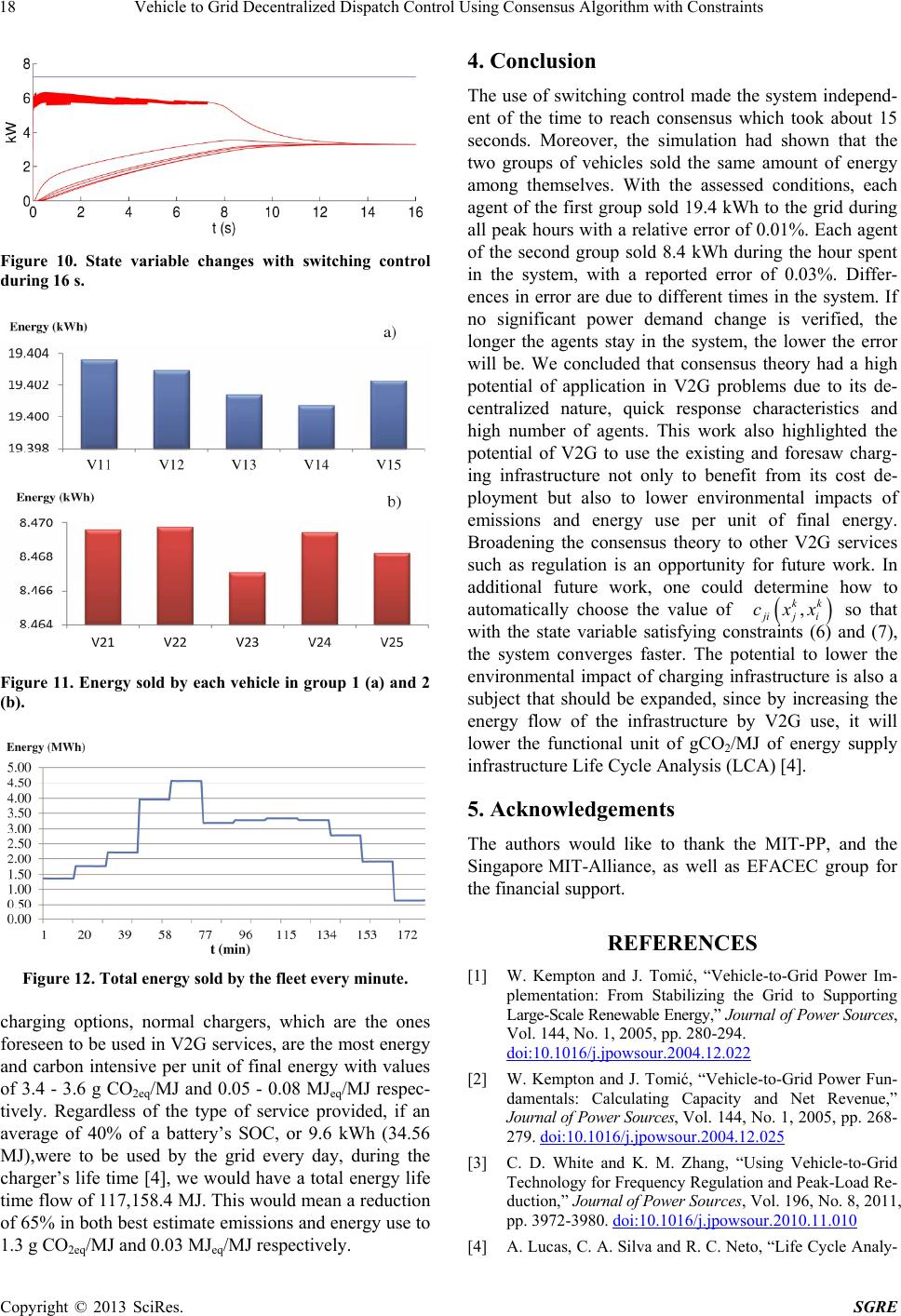 Vehicle to Grid Decentralized Dispatch Control Using Consensus Algorithm with Constraints 18 Figure 10. State variable changes with switching control during 16 s. Figure 11. Energy sold by each vehicle in group 1 (a) and 2 (b). Figure 12. Total energy sold by the fleet every minute. charging options, normal chargers, which are the ones foreseen to be used in V2G services, are the most energy and carbon intensive per unit of final energy with values of 3.4 - 3.6 g CO2eq/MJ and 0.05 - 0.08 MJeq/MJ respec- tively. Regardless of the type of service provided, if an average of 40% of a battery’s SOC, or 9.6 kWh (34.56 MJ),were to be used by the grid every day, during the charger’s life time [4], we would have a total energy life time flow of 117,158.4 MJ. This would mean a reduction of 65% in both best estimate emissions and energy use to 1.3 g CO2eq/MJ and 0.03 MJeq/MJ respectively. 4. Conclusion The use of switching control made the system independ- ent of the time to reach consensus which took about 15 seconds. Moreover, the simulation had shown that the two groups of vehicles sold the same amount of energy among themselves. With the assessed conditions, each agent of the first group sold 19.4 kWh to the grid during all peak hours with a relative error of 0.01%. Each agent of the second group sold 8.4 kWh during the hour spent in the system, with a reported error of 0.03%. Differ- ences in error are due to different times in the system. If no significant power demand change is verified, the longer the agents stay in the system, the lower the error will be. We concluded that consensus theory had a high potential of application in V2G problems due to its de- centralized nature, quick response characteristics and high number of agents. This work also highlighted the potential of V2G to use the existing and foresaw charg- ing infrastructure not only to benefit from its cost de- ployment but also to lower environmental impacts of emissions and energy use per unit of final energy. Broadening the consensus theory to other V2G services such as regulation is an opportunity for future work. In additional future work, one could determine how to automatically choose the value of , kk iji cxx so that with the state variable satisfying constraints (6) and (7), the system converges faster. The potential to lower the environmental impact of charging infrastructure is also a subject that should be expanded, since by increasing the energy flow of the infrastructure by V2G use, it will lower the functional unit of gCO2/MJ of energy supply infrastructure Life Cycle Analysis (LCA) [4]. 5. Acknowledgements The authors would like to thank the MIT-PP, and the Singapore MIT-Alliance, as well as EFACEC group for the financial support. REFERENCES [1] W. Kempton and J. Tomić, “Vehicle-to-Grid Power Im- plementation: From Stabilizing the Grid to Supporting Large-Scale Renewable Energy,” Journal of Power Sources, Vol. 144, No. 1, 2005, pp. 280-294. doi:10.1016/j.jpowsour.2004.12.022 [2] W. Kempton and J. Tomić, “Vehicle-to-Grid Power Fun- damentals: Calculating Capacity and Net Revenue,” Journal of Power Sources, Vol. 144, No. 1, 2005, pp. 268- 279. doi:10.1016/j.jpowsour.2004.12.025 [3] C. D. White and K. M. Zhang, “Using Vehicle-to-Grid Technology for Frequency Regulation and Peak-Load Re- duction,” Journal of Power Sources, Vol. 196, No. 8, 2011, pp. 3972-3980. doi:10.1016/j.jpowsour.2010.11.010 [4] A. Lucas, C. A. Silva and R. C. Neto, “Life Cycle Analy- Copyright © 2013 SciRes. SGRE 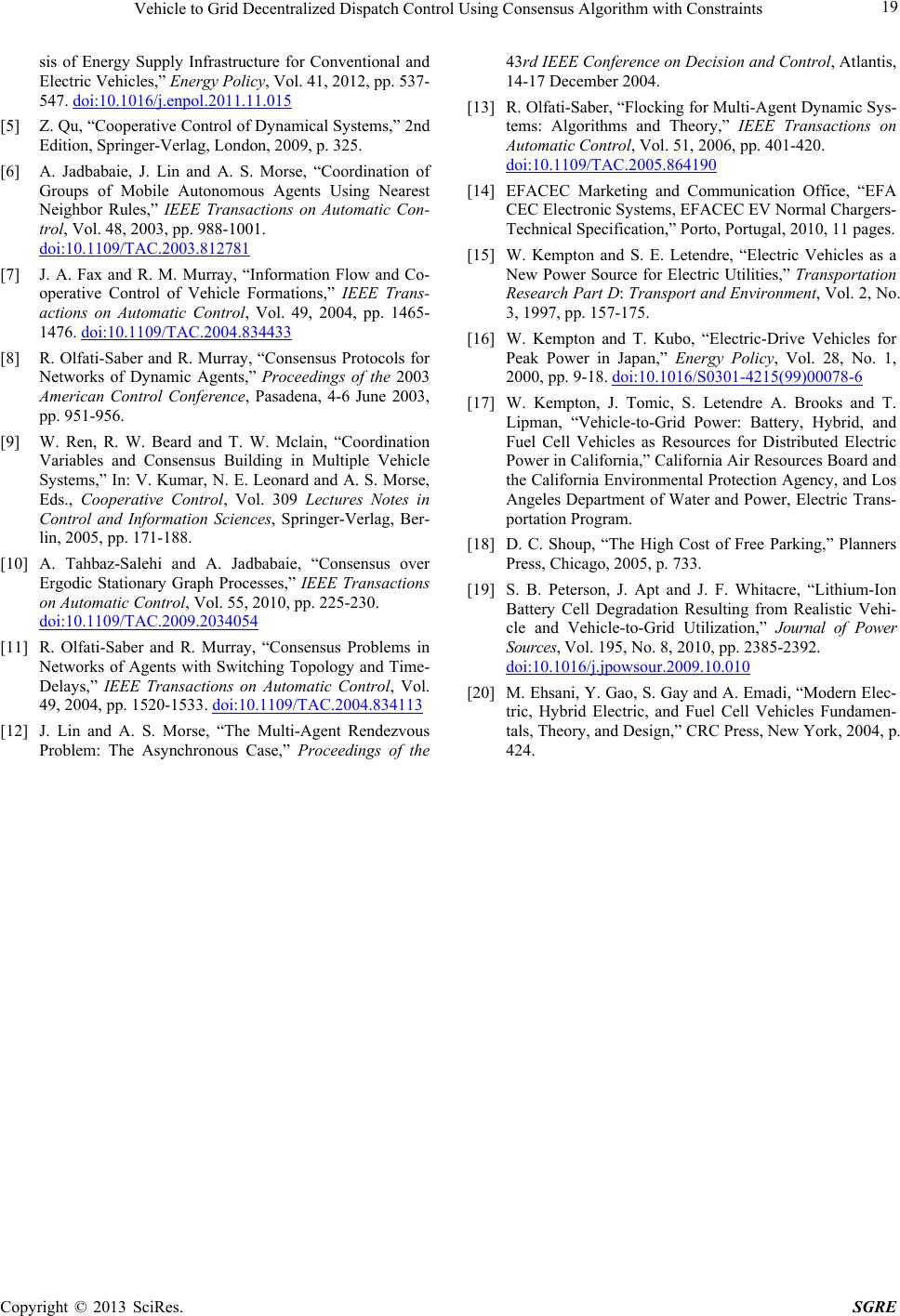 Vehicle to Grid Decentralized Dispatch Control Using Consensus Algorithm with Constraints Copyright © 2013 SciRes. SGRE 19 sis of Energy Supply Infrastructure for Conventional and Electric Vehicles,” Energy Policy, Vol. 41, 2012, pp. 537- 547. doi:10.1016/j.enpol.2011.11.015 [5] Z. Qu, “Cooperative Control of Dynamical Systems,” 2nd Edition, Springer-Verlag, London, 2009, p. 325. [6] A. Jadbabaie, J. Lin and A. S. Morse, “Coordination of Groups of Mobile Autonomous Agents Using Nearest Neighbor Rules,” IEEE Transactions on Automatic Con- trol, Vol. 48, 2003, pp. 988-1001. doi:10.1109/TAC.2003.812781 [7] J. A. Fax and R. M. Murray, “Information Flow and Co- operative Control of Vehicle Formations,” IEEE Trans- actions on Automatic Control, Vol. 49, 2004, pp. 1465- 1476. doi:10.1109/TAC.2004.834433 [8] R. Olfati-Saber and R. Murray, “Consensus Protocols for Networks of Dynamic Agents,” Proceedings of the 2003 American Control Conference, Pasadena, 4-6 June 2003, pp. 951-956. [9] W. Ren, R. W. Beard and T. W. Mclain, “Coordination Variables and Consensus Building in Multiple Vehicle Systems,” In: V. Kumar, N. E. Leonard and A. S. Morse, Eds., Cooperative Control, Vol. 309 Lectures Notes in Control and Information Sciences, Springer-Verlag, Ber- lin, 2005, pp. 171-188. [10] A. Tahbaz-Salehi and A. Jadbabaie, “Consensus over Ergodic Stationary Graph Processes,” IEEE Transactions on Automatic Control, Vol. 55, 2010, pp. 225-230. doi:10.1109/TAC.2009.2034054 [11] R. Olfati-Saber and R. Murray, “Consensus Problems in Networks of Agents with Switching Topology and Time- Delays,” IEEE Transactions on Automatic Control, Vol. 49, 2004, pp. 1520-1533. doi:10.1109/TAC.2004.834113 [12] J. Lin and A. S. Morse, “The Multi-Agent Rendezvous Problem: The Asynchronous Case,” Proceedings of the 43rd IEEE Conference on Decision and Control, Atlantis, 14-17 December 2004. [13] R. Olfati-Saber, “Flocking for Multi-Agent Dynamic Sys- tems: Algorithms and Theory,” IEEE Transactions on Automatic Control, Vol. 51, 2006, pp. 401-420. doi:10.1109/TAC.2005.864190 [14] EFACEC Marketing and Communication Office, “EFA CEC Electronic Systems, EFACEC EV Normal Chargers- Technical Specification,” Porto, Portugal, 2010, 11 pages. [15] W. Kempton and S. E. Letendre, “Electric Vehicles as a New Power Source for Electric Utilities,” Transportation Research Part D: Transport and Environment, Vol. 2, No. 3, 1997, pp. 157-175. [16] W. Kempton and T. Kubo, “Electric-Drive Vehicles for Peak Power in Japan,” Energy Policy, Vol. 28, No. 1, 2000, pp. 9-18. doi:10.1016/S0301-4215(99)00078-6 [17] W. Kempton, J. Tomic, S. Letendre A. Brooks and T. Lipman, “Vehicle-to-Grid Power: Battery, Hybrid, and Fuel Cell Vehicles as Resources for Distributed Electric Power in California,” California Air Resources Board and the California Environmental Protection Agency, and Los Angeles Department of Water and Power, Electric Trans- portation Program. [18] D. C. Shoup, “The High Cost of Free Parking,” Planners Press, Chicago, 2005, p. 733. [19] S. B. Peterson, J. Apt and J. F. Whitacre, “Lithium-Ion Battery Cell Degradation Resulting from Realistic Vehi- cle and Vehicle-to-Grid Utilization,” Journal of Power Sources, Vol. 195, No. 8, 2010, pp. 2385-2392. doi:10.1016/j.jpowsour.2009.10.010 [20] M. Ehsani, Y. Gao, S. Gay and A. Emadi, “Modern Elec- tric, Hybrid Electric, and Fuel Cell Vehicles Fundamen- tals, Theory, and Design,” CRC Press, New York, 2004, p. 424.  Vehicle to Grid Decentralized Dispatch Control Using Consensus Algorithm with Constraints 20 Appendix Figure 1. Load diagram used in simulation. Copyright © 2013 SciRes. SGRE
|